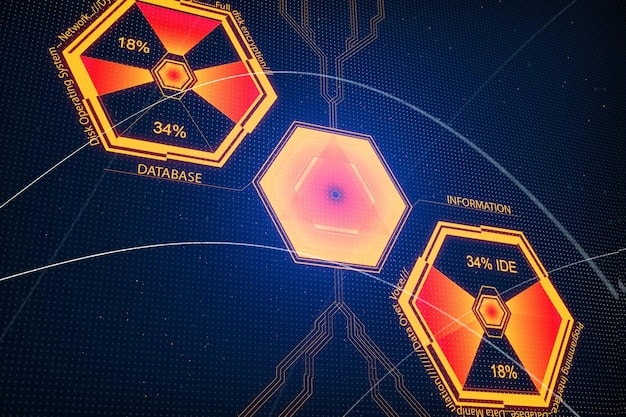Web3 Gaming in 2025: Which Blockchain Will Dominate the US?

Web3 gaming in 2025 is poised for significant growth in the US, with blockchain platforms like Ethereum, Solana, and Polygon vying for dominance by offering unique features, scalability, and developer support.
As we approach 2025, the landscape of gaming is undergoing a radical transformation, driven by the emergence of Web3 technologies. Within the US market, Web3 gaming in 2025: Which Blockchain is Dominating the US Market? becomes a pivotal question, considering the potential for innovation and disruption.
Web3 Gaming: A Primer for 2025
Web3 gaming represents a paradigm shift in how games are developed, played, and monetized. At its core, it leverages blockchain technology to introduce decentralized ownership, play-to-earn mechanics, and enhanced interoperability.
Understanding the fundamentals of Web3 gaming is crucial to predicting its future. These games often incorporate NFTs (non-fungible tokens) for in-game assets, cryptocurrencies for rewards and transactions, and DAOs (decentralized autonomous organizations) for community governance.

Key Components of Web3 Gaming
Before diving into blockchain competition, let’s clarify the key technologies driving this gaming revolution:
- NFTs (Non-Fungible Tokens): Unique digital assets representing in-game items, characters, or land, providing verifiable ownership.
- Cryptocurrencies: Used for in-game transactions, rewards, and governance, enabling a play-to-earn ecosystem.
- Decentralized Autonomous Organizations (DAOs): Empowering players to participate in game development and decision-making processes.
These elements create a gaming environment that is more engaging, transparent, and rewarding for players. By understanding these components, we can better analyze the potential for different blockchains to dominate the US market.
In conclusion, Web3 gaming, with its blend of blockchain technology and innovative game design, offers a new frontier for gamers and developers alike. The battle for supremacy among blockchain platforms will determine the direction of this exciting evolution.
The Contenders: Top Blockchains for Web3 Gaming
Several blockchain platforms are competing to become the leading choice for Web3 game developers and players. Each offers unique strengths and weaknesses in terms of scalability, transaction fees, developer tools, and community support.
Ethereum, Solana and Polygon are among the top contenders, each trying to attract game developers with different advantages:
Ethereum: The Established Leader
As the first major blockchain with smart contract capabilities, Ethereum has a significant first-mover advantage. It boasts a large developer community, extensive tooling, and a wide range of decentralized applications (dApps).
- Pros: Strong network effect, robust security, and a vast ecosystem of developers and tools.
- Cons: High transaction fees (gas fees) and scalability challenges, which can impact the gaming experience.
While Ethereum has seen major advancements such as the merge to Proof-of-Stake, the issues of scalability and gas fees continue to persist.
Solana: The Scalability Solution
Solana is designed to offer high transaction throughput and low fees, making it an attractive option for Web3 games that require fast and frequent transactions. Its innovative architecture aims to address the scalability limitations of Ethereum.
- Pros: High transaction speed, low transaction fees, and growing developer community.
- Cons: Relatively newer ecosystem, potential security vulnerabilities, and centralization concerns.
High throughput makes Solana attractive, but concerns around stability must be addressed before securing dominance.
Polygon: The Layer-2 Scaling Solution
Polygon is a layer-2 scaling solution for Ethereum, providing faster and cheaper transactions while leveraging Ethereum’s security. It offers a flexible platform for deploying Web3 games with improved user experience.
- Pros: Scalable and cost-effective transactions, Ethereum compatibility, and growing adoption by game developers.
- Cons: Dependence on Ethereum’s security, potential congestion on the main chain, and complexity in cross-chain interactions.
Polygon attempts to solve the Ethereum limitations without changing the underlying structure.

In conclusion, each of these blockchain platforms presents a compelling case for dominance in the Web3 gaming space. The eventual winner will likely be the one that can provide the best combination of scalability, security, developer support, and user experience. This is just a select few of the blockchains competing for the top spot, with many more emerging.
Analyzing the US Market: Factors Influencing Adoption
The adoption of Web3 gaming in the US market will depend on several factors, including regulatory clarity, consumer acceptance, and technological advancements. Understanding these dynamics is essential for predicting which blockchain will emerge as the leader.
Consumer attitudes and regulatory issues combine to influence popularity.
Regulatory Landscape
The regulatory environment surrounding cryptocurrencies and NFTs in the US is still evolving. Clear and consistent regulations are crucial for fostering innovation and investor confidence, paving the way for widespread adoption of Web3 gaming.
The legal status of NFTs as securities and the need for regulatory sandboxes is a key to Web3 growth. Any new policy will have a very large effect on how these technologies are used.
Consumer Acceptance
For Web3 gaming to succeed, it needs to appeal to a broad audience beyond the crypto community. This requires addressing concerns about complexity, security, and the perceived speculative nature of NFTs and cryptocurrencies.
- Ease of Use: Simplifying the user experience, making it accessible to non-crypto natives.
- Game Quality: Developing high-quality games that are fun and engaging, not just focused on play-to-earn mechanics.
- Security: Ensuring robust security measures to protect players’ assets and personal information.
Adoption rates will be closely tied to the user experience as new users are onboarded.
Technological Advancements
Ongoing technological developments, such as improved blockchain scalability and more user-friendly wallets, will play a critical role in driving Web3 gaming adoption. Advancements in AR/VR could also create new immersive gaming experiences.
Mobile compatibility and lower-cost hardware will all assist mainstream adoption, as will increases in network infrastructure.
Ultimately, the success of Web3 gaming in the US market will hinge on striking a balance between regulatory compliance, consumer acceptance, and technological innovation. The blockchain that can best navigate these challenges will be well-positioned for long-term dominance.
Developer Ecosystems: Attracting Game Creators
The strength of a blockchain’s developer ecosystem is a key indicator of its potential for success in Web3 gaming. Attracting and supporting game developers is essential for creating a vibrant ecosystem of games and applications.
Developer tooling, funding and community help determine which blockchains receive game development.
Developer Tools and Resources
Blockchains that provide comprehensive developer tools, SDKs, and documentation will have a significant advantage. These resources make it easier for developers to build and deploy games on the platform.
- SDKs (Software Development Kits): Simplifying the integration of blockchain technology into game development.
- APIs (Application Programming Interfaces): Providing access to blockchain data and functionality.
- Tutorials and Documentation: Helping developers learn and navigate the platform.
Well written and maintained tooling allows developers to rapidly prototype new games.
Funding and Grants
Many blockchain foundations offer funding and grants to support game developers. These financial incentives can attract talent and accelerate the development of innovative Web3 games.
These can be competitive, but attract new developers to the platforms that have more funding.
Community Support
A strong and active developer community provides a valuable support network for game creators. Collaboration, knowledge sharing, and mentorship can accelerate the learning process and foster innovation.
Without a community, smaller developers can struggle without readily available assistance.
In conclusion, the blockchain that can cultivate the strongest and most supportive developer ecosystem will be best positioned to attract game creators and ultimately dominate the Web3 gaming landscape. This means platforms must actively invest in developer tools, funding opportunities, and community building initiatives.
Gaming Guilds and DAOs: Shaping the Future of Play
Gaming guilds and DAOs are emerging as influential forces in the Web3 gaming ecosystem. These decentralized organizations are reshaping the way games are played, governed, and monetized.
Guilds and DAOs democratize the gaming ecosystem.
Gaming Guilds
Gaming guilds are communities of players who pool resources, share knowledge, and collaborate to maximize their earnings in play-to-earn games. They provide opportunities for players to access expensive NFTs, learn game strategies, and earn rewards.
Guilds help players who may not be able to progress as easily alone.
Decentralized Autonomous Organizations (DAOs)
DAOs are community-led organizations governed by smart contracts, enabling players to participate in decision-making processes related to game development, governance, and resource allocation.
- Governance: Players can vote on proposals and influence the direction of the game.
- Resource Allocation: DAOs can manage in-game assets, allocate rewards, and fund community initiatives.
- Community Building: DAOs foster a sense of ownership and collaboration among players.
These groups can be extremely influential in deciding the direction of a game’s ecosystem.
Overall, gaming guilds and DAOs are empowering players, fostering community involvement, and driving innovation in the Web3 gaming space. Their impact on the industry is poised to grow as more games embrace decentralized governance and play-to-earn mechanics. In the US market, these groups act as a powerful community.
Predictions for 2025: Which Chain Will Reign Supreme?
Predicting the future is always challenging, but based on current trends and developments, we can make some informed forecasts about which blockchain is most likely to dominate the Web3 gaming market in the US by 2025.
The most likely chains will have low fees, large communities and be easy to develop for.
Ethereum’s Transition
While Ethereum faces ongoing scalability challenges, its strong network effect, developer community, and move to Proof-of-Stake position it as a major contender. If layer-2 solutions like Polygon continue to gain traction, Ethereum could remain a dominant force.
If Ethereum can solve the scaling issues, it will have a very large presence.
Solana’s Upsurge
Solana’s high transaction throughput and low fees make it an attractive option for Web3 games that require fast and frequent transactions. If Solana can address its security concerns and expand its developer ecosystem, it has the potential to disrupt the market.
Providing it remains online, Solana is poised to grow rapidly.
Polygon’s Continued Growth
Polygon’s compatibility with Ethereum, scalability, and growing adoption by game developers make it a strong contender. As a layer-2 solution, Polygon can benefit from Ethereum’s security while offering a better user experience for gamers.
As long as Ethereum remains active, Polygon will also be relevant.
In conclusion, the race to dominate Web3 gaming in the US market is far from over. Ethereum, Solana, and Polygon each have strengths and weaknesses that will shape their trajectory over the next few years. The eventual winner will likely be the chain that can best adapt to the evolving needs of game developers and players while navigating the regulatory landscape and technological advancements of the industry.
| Key Aspect | Brief Description |
|---|---|
| 🎮 Web3 Gaming | Decentralized gaming using blockchain tech. |
| 💰 Play-to-Earn | Players earn rewards via in-game activity. |
| ⛓️ Top Blockchains | Ethereum, Solana and Polygon are top contenders. |
| ⚖️ Regulations | Clarity needed for widespread adoption. |
FAQ
▼
Web3 gaming is a new form of gaming that incorporates blockchain technology, NFTs, and cryptocurrencies. This enables decentralized ownership, play-to-earn mechanics, and enhanced interoperability.
▼
The benefits of Web3 gaming are increased ownership through digital scarcity, community participation, and the opportunity to earn rewards through play-to-earn models. Players have more control and can profit from their gaming activity.
▼
Several blockchains are suitable for Web3 gaming, including Ethereum, Solana, and Polygon. Ethereum offers extensive tooling, Solana provides high speed, and Polygon offers scaling solutions.
▼
Gaming guilds help players collaborate, share resources, and learn strategies, especially in play-to-earn games. These guilds provide access to expensive NFTs and increase earnings by coordinating gameplay.
▼
Regulatory concerns include the legal status of NFTs, the need for clear guidelines, and compliance with securities law. Clear and consistent regulations are vital for fostering innovation and investor confidence in Web3 gaming.
Conclusion
The Web3 gaming landscape in the US is on the cusp of significant transformation by 2025. The battle between leading blockchains like Ethereum, Solana, and Polygon will determine the future of decentralized gaming. Success hinges on innovation, regulatory clarity, and user experience.





